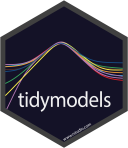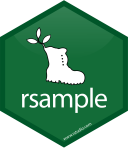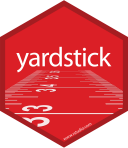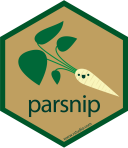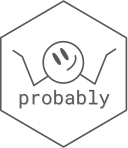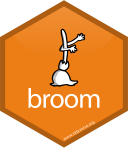1 - Feature Engineering
Advanced tidymodels
Working with our predictors
We might want to modify our predictors columns for a few reasons:
- The model requires them in a different format (e.g. dummy variables for linear regression).
- The model needs certain data qualities (e.g. same units for K-NN).
- The outcome is better predicted when one or more columns are transformed in some way (a.k.a “feature engineering”).
The first two reasons are fairly predictable (next page).
The last one depends on your modeling problem.
What is feature engineering?
Think of a feature as some representation of a predictor that will be used in a model.
Example representations:
- Interactions
- Polynomial expansions/splines
- Principal component analysis (PCA) feature extraction
There are a lot of examples in Feature Engineering and Selection (FES).
Example: Dates
How can we represent date columns for our model?
When we use a date column in its native format, most models in R convert it to an integer.
We can re-engineer it as:
- Days since a reference date
- Day of the week
- Month
- Year
- Indicators for holidays
General definitions ![]()
Data preprocessing steps allow your model to fit.
Feature engineering steps help the model do the least work to predict the outcome as well as possible.
The recipes package can handle both!
Hotel Data ![]()
![]()
We’ll use data on hotels to predict the cost of a room.
The data are in the modeldatatoo package. We’ll sample down the data and refactor some columns:
Data splitting strategy
Data Spending ![]()
Let’s split the data into a training set (75%) and testing set (25%):
Your turn
Let’s take some time and investigate the training data. The outcome is avg_price_per_room.
Are there any interesting characteristics of the data?
10:00
Resampling Strategy
Resampling Strategy ![]()
We’ll use simple 10-fold cross-validation (stratified sampling):
set.seed(472)
hotel_rs <- vfold_cv(hotel_tr, strata = avg_price_per_room)
hotel_rs
#> # 10-fold cross-validation using stratification
#> # A tibble: 10 × 2
#> splits id
#> <list> <chr>
#> 1 <split [3372/377]> Fold01
#> 2 <split [3373/376]> Fold02
#> 3 <split [3373/376]> Fold03
#> 4 <split [3373/376]> Fold04
#> 5 <split [3373/376]> Fold05
#> 6 <split [3374/375]> Fold06
#> 7 <split [3375/374]> Fold07
#> 8 <split [3376/373]> Fold08
#> 9 <split [3376/373]> Fold09
#> 10 <split [3376/373]> Fold10Prepare your data for modeling ![]()
- The recipes package is an extensible framework for pipeable sequences of preprocessing and feature engineering steps.
- Statistical parameters for the steps can be estimated from an initial data set and then applied to other data sets.
- The resulting processed output can be used as inputs for statistical or machine learning models.
A first recipe ![]()
- The
recipe()function assigns columns to roles of “outcome” or “predictor” using the formula
A first recipe ![]()
summary(hotel_rec)
#> # A tibble: 28 × 4
#> variable type role source
#> <chr> <list> <chr> <chr>
#> 1 lead_time <chr [2]> predictor original
#> 2 arrival_date_day_of_month <chr [2]> predictor original
#> 3 stays_in_weekend_nights <chr [2]> predictor original
#> 4 stays_in_week_nights <chr [2]> predictor original
#> 5 adults <chr [2]> predictor original
#> 6 children <chr [2]> predictor original
#> 7 babies <chr [2]> predictor original
#> 8 meal <chr [3]> predictor original
#> 9 country <chr [3]> predictor original
#> 10 market_segment <chr [3]> predictor original
#> # ℹ 18 more rowsThe type column contains information on the variables
Your turn
What do you think are in the type vectors for the lead_time and country columns?
02:00
Create indicator variables ![]()
For any factor or character predictors, make binary indicators.
There are many recipe steps that can convert categorical predictors to numeric columns.
step_dummy()records the levels of the categorical predictors in the training set.
Filter out constant columns ![]()
In case there is a factor level that was never observed in the training data (resulting in a column of all 0s), we can delete any zero-variance predictors that have a single unique value.
Normalization ![]()
This centers and scales the numeric predictors.
The recipe will use the training set to estimate the means and standard deviations of the data.
- All data the recipe is applied to will be normalized using those statistics (there is no re-estimation).
Reduce correlation ![]()
To deal with highly correlated predictors, find the minimum set of predictor columns that make the pairwise correlations less than the threshold.
Other possible steps ![]()
PCA feature extraction…
Other possible steps ![]()
![]()
A fancy machine learning supervised dimension reduction technique…
Other possible steps ![]()
Nonlinear transforms like natural splines, and so on!
Your turn

Create a recipe() for the hotel data to:
- use a Yeo-Johnson (YJ) transformation on
lead_time - convert factors to indicator variables
- remove zero-variance variables
03:00
Minimal recipe ![]()
Measuring Performance ![]()
We’ll compute two measures: mean absolute error and the coefficient of determination (a.k.a \(R^2\)).
\[\begin{align} MAE &= \frac{1}{n}\sum_{i=1}^n |y_i - \hat{y}_i| \notag \\ R^2 &= cor(y_i, \hat{y}_i)^2 \end{align}\]
The focus will be on MAE for parameter optimization. We’ll use a metric set to compute these:
Using a workflow ![]()
![]()
![]()
![]()
set.seed(9)
hotel_lm_wflow <-
workflow() %>%
add_recipe(hotel_indicators) %>%
add_model(linear_reg())
ctrl <- control_resamples(save_pred = TRUE)
hotel_lm_res <-
hotel_lm_wflow %>%
fit_resamples(hotel_rs, control = ctrl, metrics = reg_metrics)
collect_metrics(hotel_lm_res)
#> # A tibble: 2 × 6
#> .metric .estimator mean n std_err .config
#> <chr> <chr> <dbl> <int> <dbl> <chr>
#> 1 mae standard 17.3 10 0.199 Preprocessor1_Model1
#> 2 rsq standard 0.874 10 0.00400 Preprocessor1_Model1Your turn

Use fit_resamples() to fit your workflow with a recipe.
Collect the predictions from the results.
05:00
Holdout predictions ![]()
![]()
![]()
![]()
# Since we used `save_pred = TRUE`
lm_val_pred <- collect_predictions(hotel_lm_res)
lm_val_pred %>% slice(1:7)
#> # A tibble: 7 × 5
#> id .pred .row avg_price_per_room .config
#> <chr> <dbl> <int> <dbl> <chr>
#> 1 Fold01 62.1 20 40 Preprocessor1_Model1
#> 2 Fold01 48.0 28 54 Preprocessor1_Model1
#> 3 Fold01 64.6 45 50 Preprocessor1_Model1
#> 4 Fold01 45.8 49 42 Preprocessor1_Model1
#> 5 Fold01 45.8 61 49 Preprocessor1_Model1
#> 6 Fold01 30.0 66 40 Preprocessor1_Model1
#> 7 Fold01 38.8 88 49 Preprocessor1_Model1Calibration Plot ![]()
What do we do with the agent and company data?
There are 98 unique agent values and 100 unique companies in our training set. How can we include this information in our model?
We could:
make the full set of indicator variables 😳
lump agents and companies that rarely occur into an “other” group
use feature hashing to create a smaller set of indicator variables
use effect encoding to replace the
agentandcompanycolumns with the estimated effect of that predictor (in the extra materials)
Per-agent statistics
Collapsing factor levels ![]()
There is a recipe step that will redefine factor levels based on their frequency in the training set:
Using this code, 34 agents (out of 98) were collapsed into “other” based on the training set.
We could try to optimize the threshold for collapsing (see the next set of slides on model tuning).
Does othering help? ![]()
![]()
hotel_other_wflow <-
hotel_lm_wflow %>%
update_recipe(hotel_other_rec)
hotel_other_res <-
hotel_other_wflow %>%
fit_resamples(hotel_rs, control = ctrl, metrics = reg_metrics)
collect_metrics(hotel_other_res)
#> # A tibble: 2 × 6
#> .metric .estimator mean n std_err .config
#> <chr> <chr> <dbl> <int> <dbl> <chr>
#> 1 mae standard 17.4 10 0.205 Preprocessor1_Model1
#> 2 rsq standard 0.874 10 0.00417 Preprocessor1_Model1Aabout the same MAE and much faster to complete.
Now let’s look at a more sophisticated tool called effect feature hashing.
Feature Hashing
Between agent and company, simple dummy variables would create 198 new columns (that are mostly zeros).
Another option is to have a binary indicator that combines some levels of these variables.
Feature hashing (for more see FES, SMLTAR, and TMwR):
- uses the character values of the levels
- converts them to integer hash values
- uses the integers to assign them to a specific indicator column.
Feature Hashing
Suppose we want to use 32 indicator variables for agent.
For a agent with value “Max_Kuhn”, a hashing function converts it to an integer (say 210397726).
To assign it to one of the 32 columns, we would use modular arithmetic to assign it to a column:
Hash functions are meant to emulate randomness.
Feature Hashing Pros
- The procedure will automatically work on new values of the predictors.
- It is fast.
- “Signed” hashes add a sign to help avoid aliasing.
Feature Hashing Cons
- There is no real logic behind which factor levels are combined.
- We don’t know how many columns to add (more in the next section).
- Some columns may have all zeros.
- If a indicator column is important to the model, we can’t easily determine why.
Feature Hashing in recipes ![]()
![]()
![]()
The textrecipes package has a step that can be added to the recipe:
library(textrecipes)
hash_rec <-
recipe(avg_price_per_room ~ ., data = hotel_tr) %>%
step_YeoJohnson(lead_time) %>%
# Defaults to 32 signed indicator columns
step_dummy_hash(agent) %>%
step_dummy_hash(company) %>%
# Regular indicators for the others
step_dummy(all_nominal_predictors()) %>%
step_zv(all_predictors())
hotel_hash_wflow <-
hotel_lm_wflow %>%
update_recipe(hash_rec)Feature Hashing in recipes ![]()
![]()
![]()
hotel_hash_res <-
hotel_hash_wflow %>%
fit_resamples(hotel_rs, control = ctrl, metrics = reg_metrics)
collect_metrics(hotel_hash_res)
#> # A tibble: 2 × 6
#> .metric .estimator mean n std_err .config
#> <chr> <chr> <dbl> <int> <dbl> <chr>
#> 1 mae standard 17.5 10 0.256 Preprocessor1_Model1
#> 2 rsq standard 0.872 10 0.00395 Preprocessor1_Model1About the same performance but now we can handle new values.
Debugging a recipe
- Typically, you will want to use a workflow to estimate and apply a recipe.
- If you have an error and need to debug your recipe, the original recipe object (e.g.
hash_rec) can be estimated manually with a function calledprep(). It is analogous tofit(). See TMwR section 16.4
- Another function (
bake()) is analogous topredict(), and gives you the processed data back.
- The
tidy()function can be used to get specific results from the recipe.
Example ![]()
![]()
More on recipes
- Once
fit()is called on a workflow, changing the model does not re-fit the recipe.
- A list of all known steps is at https://www.tidymodels.org/find/recipes/.
- Some steps can be skipped when using
predict().
- The order of the steps matters.

